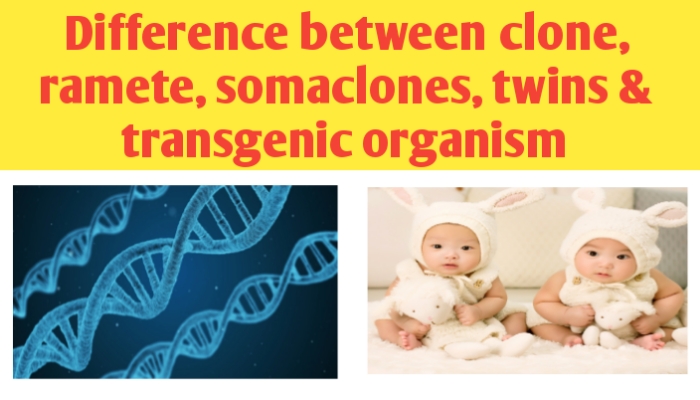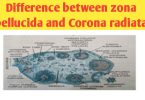Difference between clone, ramete, somaclones, twins & transgenic organism | difference between clone and ramete | difference between clones and somaclones | difference between clones and twins | difference between clone and transgenic organisms
All you have familiar with the term clone, ramet, transgenic organism, somaclones and twins, all are related to each other, some some have little difference and other has wider difference.
Clone is by product of asexual reproduction in prokaryotic organisms like bacteria whereas group of identical organism formed clonal Colony in population in a specific location, individual member of clonal Colony is known as ramet, if variation arises in clonal Colony, it’s leads development of other new individual which have different appearance known as somaclone. Whereas genetically modified organisms is known as a transgenic organism developed by introducing foreign DNA or Recombinant DNA material however identical twins developed by the efforts of sexual reproduction which have similar appearance.

Difference between clone, ramete, somaclones, twins & transgenic organism
Table of Contents
What is clone, ramete, somaclones, twins & transgenic organism?
What is clone?, clone is living organism or genetical identical individual which is formed as a result of asexual reproduction specially mitotic cell division in a somatic cells of prokaryotic organisms like bacteria.
What is ramete?, ramet is a individual member of a clonal Colony which is consist of group of a genetically identical individuals grown in a particular location which are asexually develop in some fungi and bacteria
What is somaclones? Group of genetically identical members of clonal Colony affected by environmental factors, leads to variation arises in colony and new individuals are formed known as somaclones
What is twins?, twins are more than one offspring produced by the same pregnancy a result of sexual reproduction. This can be either monozygotic which is identical twin, meaning that they develop from one zygote, which splits and forms two embryos, or dizygotic, meaning that each twin develops from a separate egg and each egg is fertilized by its own sperm cell which are not identical twins.
What is transgenic organism?, genetically modified organisms are called transgenic organisms produced by inserting genetic material from another species or Recombinant DNA such that new genetic material will provide ability to exhibit some desirable traits.
What is the difference between clone and ramete?
This questions is very important for class 12th Biology students those who are preparing for CBSE Board/ States board annual and other competitive medical Neet examinations
List 3 Difference/ differentiate/ comparison distinguish/ versus/ how does differ from/ between clone and ramete are following:-
Key difference between clone and ramete is that clone is morphologically and genetically similar individuals develop as a result of asexual reproduction in somatic cells of prokaryotic organism like bacteria whereas ramet is a individual member of a clonal Colony which is consist of group of a genetically identical individuals grown in a particular location which are asexually develop in some fungi and bacteria.
What is the difference between clones and somaclones?
This questions is very important for class 12th Biology students those who are preparing for CBSE Board/ States board annual and other competitive medical Neet examinations
List 3 Difference/ differentiate/ comparison distinguish/ versus/ how does differ from/ between clones and somaclones are following:-
Key difference between clones and somaclones is that clones are morphologically and genetically similar individuals develop as a result of asexual reproduction is specially mitotic cell division in somatic cells of prokaryotic organism like bacteria without fusion and formation of gametes whereas somaclones are group of new individuals developed in clonal colony population as a result of environmental factors, leads to variation arises in colony and new individuals are formed known as somaclones.
What is the difference between clones and twins?
This questions is very important for class 12th Biology students those who are preparing for CBSE Board/ States board annual and other competitive medical Neet examinations
List 3 Difference/ differentiate/ comparison distinguish/ versus/ how does differ from/ between clones and twins are following:-
Key difference between clones and twins is that clones are morphologically and genetically similar individuals develop as a result of asexual reproduction is specially mitotic cell division in somatic cells of prokaryotic organism like bacteria without fusion and formation of gametes and usually it is monoparental whereas twins are more than one offspring produced by the same pregnancy a result of sexual reproduction by fusion and formation of gametes, it may be identical or not and usually it is biparental.
You can also click on the given link to see others topic in our website and YouTube channels
● primary and secondary follicle difference
● Purines and Pyrimidine compare
What is the difference between clone and transgenic organisms?
This questions is very important for class 12th Biology students those who are preparing for CBSE Board/ States board annual and other competitive medical Neet examinations
List 3 Difference/ differentiate/ comparison distinguish/ versus/ how does differ from/ between clone and transgenic organisms are following:-
Key difference between clones and transgenic organisms is that clone is living organism or genetical identical individual which is formed as a result of asexual reproduction specially mitotic cell division in a somatic cells of prokaryotic organisms like bacteria whereas transgenic organisms are genetically modified organisms are called transgenic organisms produced by inserting genetic material from another species or Recombinant DNA such that new genetic material will provide ability to exhibit some desirable traits.







Leave a Comment